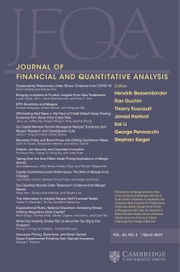No CrossRef data available.
Article contents
Trading in Crowded Markets
Published online by Cambridge University Press: 27 June 2025
Abstract
We study trading among strategic traders who may incorrectly assess the degree of market crowdedness. These mistakes distort equilibrium strategies and prices. When traders underestimate market crowdedness, they target larger inventories and trade more aggressively, but their actual profits are lower than expected because they underestimate the amount of information already impounded in prices. Crowded markets are prone to abrupt crashes. The magnitude of price dislocations and the speed of recovery during fire-sale events can help infer traders’ beliefs about market crowdedness.
Information
- Type
- Research Article
- Information
- Copyright
- © The Author(s), 2025. Published by Cambridge University Press on behalf of the Michael G. Foster School of Business, University of Washington
Footnotes
We thank Stepan Gorban for research assistance at the early stage of this article. We thank Bradyn Breon-Drish, Giovanni Cespa, Mark Loewenstein, Liyan Yang, Haoxiang Zhu, and seminar participants at Baruch College, UIUC, University of Maryland, the 2018 Finance Theory Group Meeting, the 2018 NYU Stern Microstructure Conference, and the 2019 Western Finance Association Meetings for helpful comments.

